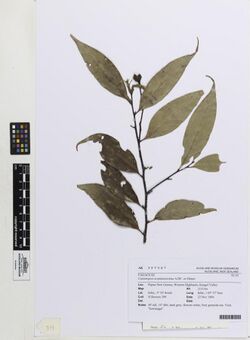Biology:Castanopsis acuminatissima
| Castanopsis acuminatissima | |
|---|---|

| |
| Scientific classification | |
| Kingdom: | Plantae |
| Clade: | Tracheophytes |
| Clade: | Angiosperms |
| Clade: | Eudicots |
| Clade: | Rosids |
| Order: | Fagales |
| Family: | Fagaceae |
| Genus: | Castanopsis |
| Species: | C. acuminatissima
|
| Binomial name | |
| Castanopsis acuminatissima (Blume) A.DC.
| |
| Synonyms | |
| |
Castanopsis acuminatissima is an evergreen tree native to Southeast Asia and New Guinea. It is known by a variety of common names over its range, including white oak, New Guinea oak, Papua New Guinea oak, ki riung, ko-duai, ko-soi, ko-mat, meranak, and riung anak.[2]
Description
Castanopsis acuminatissima is a large canopy tree, up to 40 meters in height. The trunk is markedly fluted, and sometimes buttressed. The bark is grey or pale brown, rough and fissured, less than 25 mm thick, with red under-bark.
Leaves are simple, 9.0-11.5 cm long and 2.5-3.5 cm wide, and arranged spirally along the branches. Fruits are simple nuts, 1–10 mm in diameter.[3]
Distribution and habitat
Castanopsis acuminatissima ranges from southwestern China (Guizhou and Yunnan provinces) through Indochina (Laos, Myanmar, Thailand, Vietnam, and the Chittagong Hills of Bangladesh) and Malesia (Malaysia; the islands of Sulawesi, Java, Kalimantan, and Sumatra, in Indonesia; the islands of New Guinea (West Papua in Indonesia and Papua New Guinea) and New Britain (Papua New Guinea)).[4][5]
Habitat and ecology
Castanopsis acuminatissima is native to lowland dipterocarp rain forests and montane rain forests from 300 up to 2,500 meters elevation.[1]
In New Guinea and New Britain, it is a predominant tree in the lower montane forests, lying between 900-1000 and 2000 meters elevation.[6] It can also be found at lower elevations on small-crowned hill forests, in association with Hopea papuana and the drought-tolerant Casuarina papuana.[7]
References
- ↑ 1.0 1.1 Barstow, M. 2018. Castanopsis acuminatissima. The IUCN Red List of Threatened Species 2018: e.T62004491A62004494. https://dx.doi.org/10.2305/IUCN.UK.2018-1.RLTS.T62004491A62004494.en. Accessed 8 March 2023.
- ↑ "Castanopsis acuminatissima", World Agroforestry Centre database, accessed May 26, 2008. "Species Detail". Archived from the original on 2011-09-30. https://web.archive.org/web/20110930042518/http://www.worldagroforestrycentre.org/Sea/Products/AFDbases/WD/asps/DisplayDetail.asp?SpecID=680. Retrieved 2008-05-26.
- ↑ "Castanopsis acuminatissima", Guide to Trees of Papua New Guinea, accessed May 26, 2008 [1]
- ↑ {{citation | mode = cs1 | title = Castanopsis acuminatissima | work = Germplasm Resources Information Network (GRIN) | url = | publisher = [[Organization:Agricultural Research ServAgricultural Research Service (ARS), United States Department of Agriculture (USDA) | access-date = May 26, 2008 }}
- ↑ "Castanopsis acuminatissima", Guide to Trees of Papua New Guinea, accessed May 26, 2008 [2]
- ↑ "Central Range montane rain forests". Terrestrial Ecoregions. World Wildlife Fund. http://worldwildlife.org/ecoregions/aa0105. Retrieved May 26, 2008.
- ↑ "Papua New Guinea" FAO Forestry country profiles - natural woody vegetation, accessed May 26, 2008. [3]
Wikidata ☰ Q310280 entry
 |


